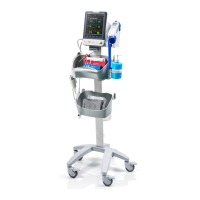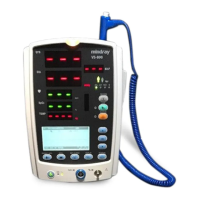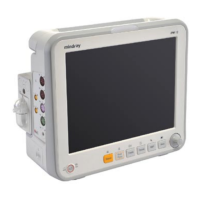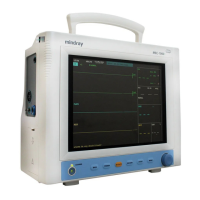VS 8/VS 8A Vital Signs Monitor Operator’s Manual 6 - 7
6.6.2 Nellcor SatSeconds
TM
Alarm Management
With traditional alarm management, high and low alarm limits are set for monitoring
oxygen saturation. During monitoring, once an alarm limit is violated, an audible alarm
immediately sounds. When the patient SpO
2
fluctuates near an alarm limit, the alarm
sounds each time the limit is violated. Such frequent alarms can be distracting. Nellcor’s
SatSeconds alarm management technique is used to reduce these nuisance alarms.
The SatSeconds feature is available with the Nellcor SpO
2
to decrease the likelihood of
false alarms caused by motion artifacts. With SatSeconds alarm management, high and
low alarm limits are set in the same way as those with traditional alarm management. A
SatSeconds limit is also set. The SatSeconds limit controls the amount of time that SpO
2
saturation may be outside the set limits before an alarm sounds.
The method of calculation is as follows: the percentage points of the SpO
2
saturation
falling outside the alarm limit is multiplied by the number of seconds remaining outside
the limit. This can be stated as the equation:
SatSeconds = Points × Seconds
Only when the SatSeconds limit is reached, the monitor gives a SatSeconds alarm. For
example, the figure below demonstrates the alarm response time with a SatSeconds
limit set at 50 and a low SpO
2
limit set at 90%. In this example, the patient SpO
2
drops to
88% (2 points) and remains there for 2 seconds. Then it drops to 86% (4 points) for 3
seconds, and then to 84% (6 points) for 6 seconds. The resulting SatSeconds are:
After approximately 11 seconds, a Sat-Second alarm would sound, because the limit of
50 SatSeconds would have been exceeded.
% SpO
2
Seconds SatSeconds
2× 2= 4
4× 3= 12
6× 6= 36
Total SatSeconds= 52
6 - 8 VS 8/VS 8A Vital Signs Monitor Operator’s Manual
Saturation levels may fluctuate rather than remaining steady for a period of several
seconds. Often, the patient SpO
2
may fluctuate above and below an alarm limit, re-
entering the non-alarm range several times. During such fluctuation, the monitor
integrates the number of SpO
2
points, both positive and negative, until either the
SatSeconds limit is reached, or the patient SpO
2
re-enters the non-alarm range and
remains there.
• The SpO
2
Too Low or SpO
2
Too High alarm is presented in the case that SpO
2
value violates the alarm limits 3 times within one minute even if the setting
of SatSeconds is not reached.
6.6.3 Setting the Nellcor SpO
2
SatSeconds
In Continuous Monitoring mode, you can set the SatSeconds. Follow this procedure:
1. Select the SpO
2
numeric area or waveform area to enter the SpO2 dialog.
2. Select the Alarm tab.
3. Set Sat-Seconds.
6.6.4 Setting SpO
2
Sensitivity (for Masimo SpO
2
)
For Masimo SpO
2
, selects the Sensitivity as per signal quality and patient motion.
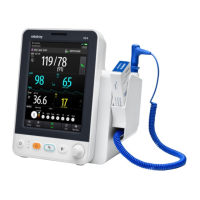
